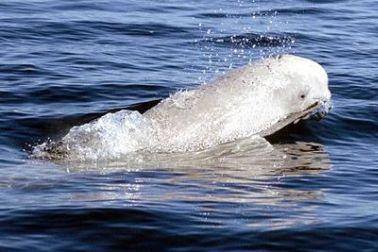
By Kristina Chew
Life under the sea is wetter but it’s not exactly getting any better for marine animals and especially for cetaceans, large aquatic mammals like whales and dolphins. Octopuses and squids are also affected. Human activity has raised the noise level of the ocean by 20 decibels ove r the last 50 years and it’s likely to get ever noisier. While we might imagine the deeps of the ocean to be silent, the reality is that military testing, freighter propellers and seismic oil and gas exploration — which uses air cannons to create tremors in the sea bed — have combined to create an “acoustic fog” that scientists compare to living in a nightclub where you have to shout to be heard.
We’re not only polluting the ocean with plastic bags, syringes and all manner of refuse. We’re creating so much din in the ocean that the very survival of many animals is in question, as cetaceans depend on their hearing to travel long distances to find food and shelter.
Mark Simmonds, the international director of science at the Whale and Dolphin Conservation Society (WDCS), says that, for cetaceans, “hearing is as important as vision is for us,” so all the ruckus we’re creating is most likely affecting their communication with each other, as well as their sense of direction. Just basic small boat traffic at low speeds in shallow waters can lessen the reach of sounds by 26 percent for bottle nose dolphins and by 58 percent for pilot whales. 15 beaked whales in the Canaries died in 2002 after a NATO exercise using anti-submarine sonars. A number of whale strandings have also been linked to military sonar use.
In particular, animals whose long-time habitat is in the arctic are finding their way of life threatened as humans venture north drilling for oil and gas:
“Narwals for example have a narrowly defined habitat,” explains Simmonds. “They are very adapted to that cold environment. If it gets too noisy, where will they go?”
The same problem applies to the highly sound-sensitive beluga, or white whale, that migrates to Canada’s northern shores.
These mammals, which are capable of detecting ships 30 kilometers (18.7 miles) away, will struggle to maintain their migration route through the narrow straits circling Baffin Island as shipping in the area risks increasing sharply to accommodate a new large-scale mining project.
Offshore wind farms are environmentally-friendly, but building them means using a hydraulic hammer to drill the sea bed, so a monopod can be affixed to it:
This so-called pile-driving can emit noise levels up to 250 decibels, which is a deadly dose for nearby marine mammals, though experts say it’s easy to diminish the threat by creating a curtain of air bubbles surrounding the drill site.
But on top of pile-driving, ship traffic linked to maintenance, cable-laying and the expansion of port infrastructure are also shrinking sea mammals’ habitats.
Michel Andre, a French researcher at the Laboratory of Applied Bioacoustics at Barcelona University, says that we actually know how to reduce the sounds made by boats. The European Commission is financing an initiative, Ships-Oriented Innovative Solutions to Reduce Noise and Vibrations, or SILENV, to create an “acoustic green label” for ships. The European Union itself has undertaken a directive to reduce noise levels in its waters.
The adverse effects of offshore oil and gas development on the ocean’s marine life providesmore evidence for why we need to protect arctic waters from industrial development. While such efforts can provide new economic opportunities, they also bring new problems in the form of “stresses to local indigenous communities and .. pressure on a fragile ecosystem that is adapting to profound environmental changes,” including noise in places that once never knew of such a thing.
Courtesy of: http://www.care2.com

